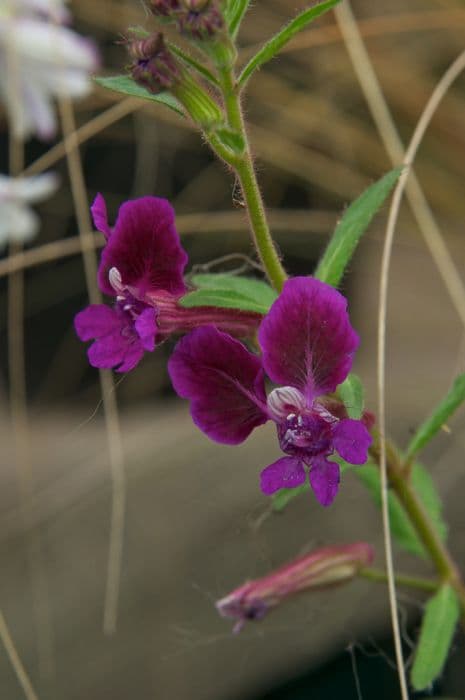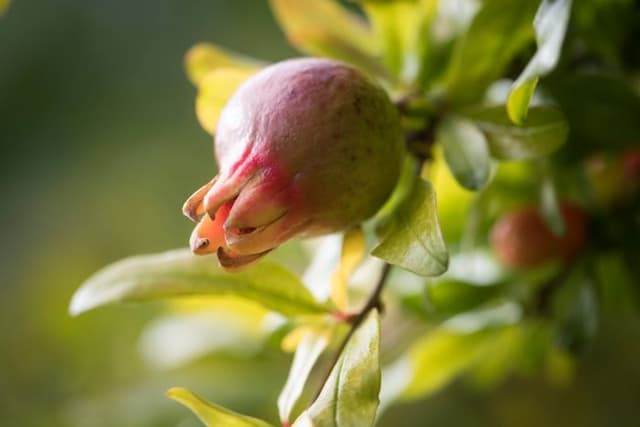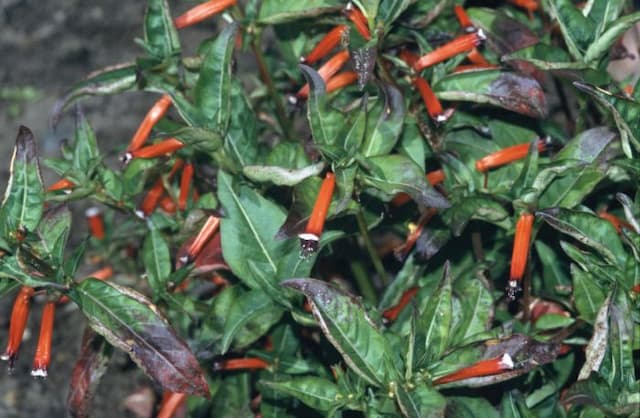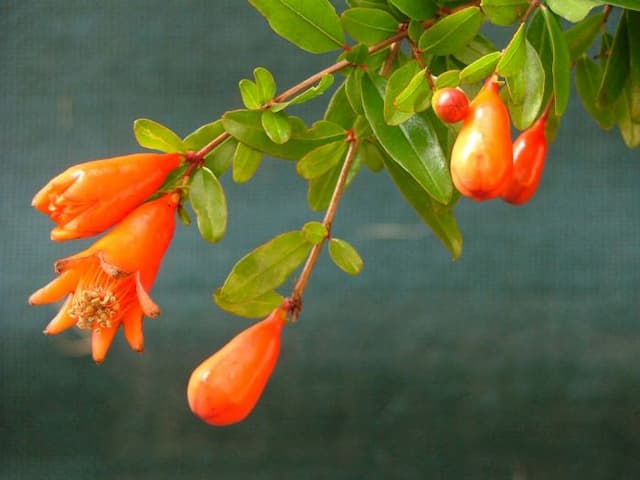Blue Waxweed Cuphea viscosissima

ABOUT
Blue waxweed is a flowering plant with a distinctive appearance. Its stems are often sticky to the touch due to the presence of glandular hairs. The leaves are arranged oppositely along the stem and are generally lance-shaped, featuring a slightly toothed margin which contributes to its ragged look. The flowers of the blue waxweed are quite showy, typically with a tubular shape that flares at the mouth into five small lobes. They are usually pink, purple, or sometimes white, and have a pleasing contrast against the lush green foliage. These blooms are often frequented by various pollinators such as bees and hummingbirds, attracted to their vibrant colors and the nectar they offer. The seeds of the blue waxweed are contained within small, rounded capsules that follow the flowering period. Once mature, these capsules may split open to release the tiny seeds within, which can propagate the plant further if they find suitable growing conditions. Overall, the blue waxweed presents a somewhat sticky, yet attractive, addition to gardens and natural areas where they occur.
About this plant
 Names
NamesFamily
Lythraceae.
Synonyms
Blue Waxweed, Clammy Cuphea, Sticky Cuphea, Tarweed.
Common names
Cuphea petiolata, Parsonsia petiolata, Parsonia viscossissima.
 Toxicity
ToxicityTo humans
Blue Waxweed (Cuphea viscosissima) is not widely recognized for being toxic to humans. There is limited information available on the toxicity of this specific species, and it is not commonly listed as a hazardous plant. However, as with any plant, some individuals may have allergic reactions or sensitivities. If Blue Waxweed is ingested and symptoms appear, it is important to seek medical attention, as individual reactions can vary.
To pets
Blue Waxweed (Cuphea viscosissima) is not well-documented for toxicity to pets, such as dogs and cats. It is not generally known to be a poisonous plant and there is limited information on its effects if ingested by pets. If a pet consumes Blue Waxweed and exhibits any unusual symptoms or behaviors, it would be advisable to consult a veterinarian. As symptoms of plant poisoning can vary widely, observation and professional advice are important if any adverse reaction is suspected.
 Characteristics
CharacteristicsLife cycle
Annuals
Foliage type
Deciduous
Color of leaves
Green
Flower color
Purple
Height
1-3 feet (0.3-0.9 meters)
Spread
1-3 feet (0.3-0.9 meters)
Plant type
Herb
Hardiness zones
5-9
Native area
North America
Benefits
 General Benefits
General Benefits- Attracts Pollinators: Cuphea viscosissima, commonly known as Blue Waxweed, is known to attract bees, butterflies, and hummingbirds, supporting local ecosystems and pollination processes.
- Garden Aesthetic: With its vibrant purple and pink flowers, Blue Waxweed adds color and visual interest to gardens and landscapes.
- Drought Tolerance: Once established, Blue Waxweed is drought-tolerant, making it a suitable choice for xeriscaping and water-wise gardens.
- Low Maintenance: Blue Waxweed is relatively easy to care for and does not require frequent watering or fertilizing, thereby reducing the time and resources needed for upkeep.
- Erosion Control: It can be used to stabilize soil in areas prone to erosion due to its root systems holding the soil in place.
- Wildlife Habitat: It provides shelter and food for a variety of wildlife, especially beneficial insects and small birds.
 Medical Properties
Medical PropertiesThis plant is not used for medical purposes.
 Air-purifying Qualities
Air-purifying QualitiesThis plant is not specifically known for air purifying qualities.
 Other Uses
Other Uses- Insect attraction: Cuphea viscosissima, commonly known as tarweed, is often planted to attract pollinators such as bees and butterflies to the garden, which can benefit the pollination of nearby plants.
- Erosion control: The dense growth habit of tarweed makes it suitable for planting in areas susceptible to soil erosion, helping to stabilize the soil.
- Ornamental landscaping: With its vibrant flowers, tarweed is frequently used in ornamental plantings to add color and texture to garden beds, borders, and containers.
- Wildlife habitat: Tarweed provides shelter and food for various wildlife, including insects and small animals, thus contributing to biodiversity in the ecosystem.
- Education and research: As a native species, tarweed can be used in educational settings or research projects to study native flora and plant-pollinator interactions.
- Cultural symbolism: In some cultures or communities, tarweed may be used in ceremonial or symbolic plantings reflecting local traditions or history.
- Companion planting: Tarweed can be used in companion planting strategies to improve the growth of certain vegetables or other garden plants by attracting beneficial insects or providing shade.
- Hobbyist cultivation: Some gardeners enjoy cultivating tarweed as part of a native plant collection or for the challenge of growing different varieties.
- Photography and art: The distinctive appearance of tarweed makes it a subject of interest for photographers and artists who wish to capture the beauty of native plants.
- Ecological restoration: Tarweed is sometimes planted as part of ecological restoration projects to re-establish native plant communities in areas where they have been disturbed or depleted.
Interesting Facts
 Feng Shui
Feng ShuiThe Tarweed is not used in Feng Shui practice.
 Zodiac Sign Compitability
Zodiac Sign CompitabilityThe Tarweed is not used in astrology practice.
 Plant Symbolism
Plant Symbolism- Attraction – Cuphea viscosissima, commonly known as the "Blue Waxweed," has brightly colored flowers that attract hummingbirds and pollinators, symbolizing allure and magnetic charm.
- Adaptability – The Blue Waxweed's capacity to thrive in a variety of conditions reflects the ability to adapt and flourish in diverse environments.
- Healing – Traditionally, some species of Cuphea have been used in herbal medicine, which may lend this plant a symbolic connection to healing and soothing properties.
 Water
WaterThe Tarweed Cuphea, commonly known as Cuphea viscosissima, should be watered regularly to keep the soil consistently moist, but not overly saturated. During active growing seasons, typically in spring and summer, watering may be necessary once every week with approximately 1 gallon of water each time, depending on the plant's size and the environmental conditions. Reduce watering frequency in the fall and winter when the plant's growth slows, ensuring the top inch of soil dries out between watering sessions. Always check the soil moisture before watering to prevent overwatering, which can lead to root rot.
 Light
LightThe Tarweed Cuphea thrives in full sun to partial shade. It is best to place the plant in a spot where it can receive at least six hours of direct sunlight per day. When grown indoors, a south or west-facing window is ideal to ensure it gets enough light. However, in extremely hot climates, some afternoon shade may be beneficial to prevent leaf scorch.
 Temperature
TemperatureThe ideal temperature range for the Tarweed Cuphea is between 60°F and 75°F. It can tolerate minimum temperatures down to around 30°F and maximum temperatures up to about 90°F. However, it should be protected from frost, as it is not frost-hardy. Placing the plant in an environment that reflects these temperature preferences will promote healthy growth and flowering.
 Pruning
PruningPruning the Tarweed Cuphea is important for maintaining its shape and encouraging bushier growth. Light pruning can be done throughout the growing season to remove dead or damaged branches and to keep the plant looking tidy. More extensive pruning should be performed in the early spring before new growth begins. This typically involves cutting the plant back by about one-third of its size to promote new stems and flowers.
 Cleaning
CleaningAs needed
 Soil
SoilBlue Waxweed prefers well-draining soil with a mix of peat, perlite, and sand. The ideal pH range for Blue Waxweed is between 6.0 and 7.5 to ensure healthy growth.
 Repotting
RepottingBlue Waxweed should be repotted every 1-2 years or when it becomes root-bound to ensure adequate space for growth.
 Humidity & Misting
Humidity & MistingBlue Waxweed thrives in moderate to high humidity levels, ideally around 50-70% for optimal growth.
 Suitable locations
Suitable locationsIndoor
Give Blue Waxweed bright light and keep the humidity high.
Outdoor
Plant Blue Waxweed in full sun to partial shade.
Hardiness zone
7-10 USDA
 Life cycle
Life cycleCuphea viscosissima, commonly known as blue waxweed, starts its life as a seed released from mature plants after the flowering stage. Upon finding suitable soil, the seeds germinate in spring or early summer, growing into seedlings with the first true sets of leaves distinct from the initial cotyledons. The seedlings mature into vegetative plants, developing a more complex root system, stems, and leaves during this growth phase. In the reproductive phase, blue waxweed produces small, tubular, pink to purple flowers that attract pollinators and facilitate cross-pollination. Following fertilization, the flowers form capsules that contain the seeds, which mature until the parent plant disperses them, thereby completing the life cycle. If conditions remain favorable, this cycle can repeat annually, as blue waxweed is typically an annual.
 Propogation
PropogationPropogation time
Spring to Summer
Cuphea viscosissima, also known as Tarweed, is typically propagated by seed. The best time to sow seeds is in spring after the danger of frost has passed. To propagate, sow the seeds directly into the soil in a location that receives full sun. The soil should be well-draining and you can lightly press the seeds into the soil but do not cover them heavily, as they need light to germinate. Keep the soil moist but not waterlogged until germination, which usually occurs within 2 to 3 weeks. Once the seedlings are large enough to handle, thin them out to prevent overcrowding. This method is effective and maintains the plant's genetic diversity as seedlings may vary slightly from their parent plant.




